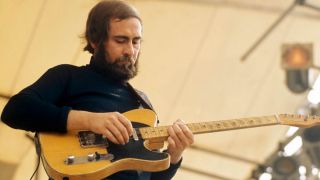In the early 1970s, PBS Television in the USA showed an extended special entitled The World’s Greatest Unknown Guitarist. But this wasn’t strictly true; by 1971, Roy Buchanan had earned himself a reputation among the rock elite, reputedly being offered the position as Brian Jones’ successor in the Rolling Stones, at the peak of their career.
This documentary did however lead onto a recording contract with Polydor Records, going some way to redress Roy’s anonymity among the general public. Of the five albums he recorded for Polydor, and the three subsequent releases for Atlantic, two of these achieved gold status. However, Roy was never comfortable with purely commercial success, and loathed intervention from the record company. He wanted complete control over his music, leading to a period of recording inactivity starting in 1981.
Things were looking up when in 1985 Buchanan accepted a contract with Alligator Records, a deal that would give him the freedom he desired and lead to the classic releases When A Guitar Plays The Blues, and Hot Wires (1987). However, Buchanan’s personal life had its complications and tragedy was to strike in 1987, as Roy was found hanged in a police cell after being arrested for public intoxication. The official verdict was given as suicide.
Roy was a true master of the Telecaster, able to coax a huge variety of sounds with just guitar, cable and amplifier turned up very loud. Buchanan’s playing was remarkably broad, stylistically, equally comfortable with blues, jazz, funk, gospel, country and much more besides. He was genuinely a true ‘Crossroads’ player, as our musical examples and solo that form the basis of this lesson illustrate.
Each of the examples highlights just a small selection of Roy’s considerable lickbag, with topics and techniques ranging from pinched harmonics to oblique bends, volume swells to chicken pickin’. Buchanan’s playing has so much to offer, so we’d urge you to check out his music directly. Use these examples as the start of your studies, perhaps taking each concept and exploring that particular idea in depth.
In fact, that’s exactly how I approached putting this article together, isolating each concept and auditioning different options against a backing loop for at least 20 minutes before solidifying each line. It’s so often a case that the journey itself is more important than the destination, so feel free to explore, improvise, change and challenge each idea until you come up with a range of options that works for you.
Example 1. Signature Buchanan phrases and concepts
We begin with a set of Roy-inspired lines against a C7 vamp (C-E-G-Bb). Each example highlights one of Buchanan’s trademark approaches, ranging from pinched harmonics (1a), through oblique bends (1b), the use of 6th intervals (1d) and onto a pair of idiomatic phrases that illustrate a deep understanding of bluesy (1i) and jazzy phrasing (1j).
From a notes perspective, Roy got a huge amount of mileage from the Blues scale, in this case in the key of C (C-Eb-F-Gb-G-Bb). Notice where the minor 3rd (Eb) is either bent slightly sharp or is immediately followed by the major 3rd (E). C Mixolydian or Dominant scale also sees some action (C-D-E-F-G-A-Bb), along with targeting phrases on those crucially important chord tones (C-Root, E-maj3rd, G-5th, Bb-b7).
Example 2. Hybrid picking exercises
As hybrid picking is such a big part of Roy’s style, we’ve included a pair of primer exercises, each around a C Major triad fingering, that you can use to get your technique in shape. In 2a) we’re utilising two-note groups articulated with an alternation of downstroke with the pick followed by a note plucked with the second finger (m).
We essentially move the pattern throughout the triad arpeggio. In 2c) we expand this pattern to take in three notes, this time with a combination of plectrum, second and third finger (a). Once again, this is moved through the triad arpeggio but this time we’re employing triplet rhythms.
Example 3. Rhythm guitar riff
Here is the rhythm guitar riff against which the previous examples are played. While the harmony is defined as C7 (C-E-G-Bb), you’ll again notice the presence of the Minor 3rd (Eb) although, as in much of the lead orientated material, this note is bent slightly sharp to blur the distinction between minor and major tonalities in a typically bluesy way. However, the double-stops in the last bar explicitly spell out the major 3rd (E natural).
Example 4. Full solo
We end this study of Roy’s playing with a full solo, again over our classic blues groove in C, although this time moving through the conventional changes for a 12-bar blues, taking in both the IV7 (F7) and V7 (G7).
This solo contextualises many of the ideas we encountered in example 1, such as volume swells, bends, melodic sequences and interval skips, chicken pickin’, oblique bends and hybrid picked string-crossing ideas.
From a notes perspective, again we’re mostly using the C blues scale throughout the solo (C-Eb-F-Gb-G-Bb). Take things steadily and be sure to watch for those all-important nuances that made Roy’s playing so special.

